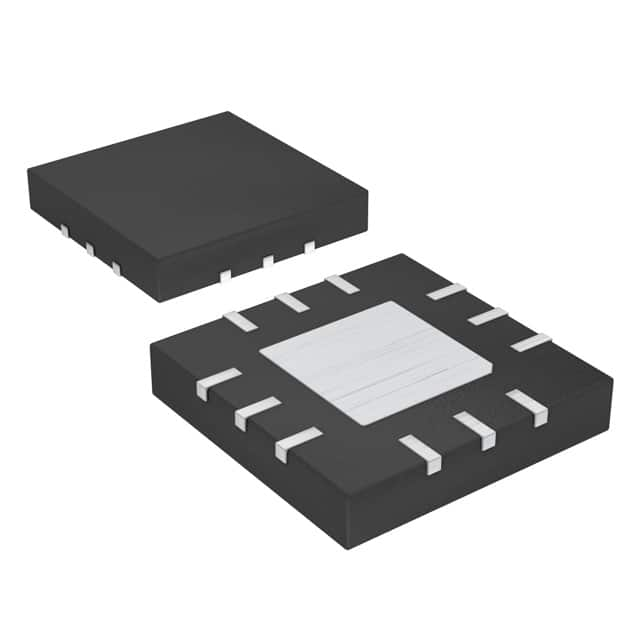MAX1926ETC+T
Product Overview
- Category: Integrated Circuit (IC)
- Use: Power Management
- Characteristics: High Efficiency, Low Power Consumption
- Package: 12-Pin Thin QFN
- Essence: Voltage Regulator
- Packaging/Quantity: Tape and Reel, 2500 units per reel
Specifications
- Input Voltage Range: 2.7V to 5.5V
- Output Voltage Range: 0.8V to 3.3V
- Maximum Output Current: 1A
- Quiescent Current: 40µA
- Switching Frequency: 1.2MHz
- Operating Temperature Range: -40°C to +85°C
Detailed Pin Configuration
The MAX1926ETC+T has a total of 12 pins. The pin configuration is as follows:
- VIN: Input Voltage
- GND: Ground
- FB: Feedback Pin
- EN: Enable Pin
- SS/TR: Soft-Start/Tracking Pin
- VOUT: Output Voltage
- PGND: Power Ground
- SW: Switch Node
- BST: Boost Capacitor Connection
- COMP: Compensation Pin
- SS/TR: Soft-Start/Tracking Pin
- VIN: Input Voltage
Functional Features
- High Efficiency: The MAX1926ETC+T offers high efficiency power conversion, minimizing energy loss.
- Low Power Consumption: With a quiescent current of only 40µA, it ensures minimal power consumption during operation.
- Wide Input Voltage Range: The IC can accept input voltages ranging from 2.7V to 5.5V, providing flexibility in various applications.
- Adjustable Output Voltage: The output voltage can be adjusted from 0.8V to 3.3V, allowing customization based on specific requirements.
- Integrated Protection Features: The MAX1926ETC+T incorporates overcurrent protection, thermal shutdown, and undervoltage lockout for enhanced reliability.
Advantages and Disadvantages
Advantages: - High efficiency power conversion - Low power consumption - Wide input voltage range - Adjustable output voltage - Integrated protection features
Disadvantages: - Limited maximum output current (1A)
Working Principles
The MAX1926ETC+T is a voltage regulator that utilizes a synchronous buck topology. It operates by converting the input voltage to a lower, regulated output voltage. The IC employs pulse-width modulation (PWM) techniques to control the switching of internal MOSFETs, ensuring efficient power conversion. The feedback mechanism adjusts the duty cycle of the switches to maintain the desired output voltage.
Detailed Application Field Plans
The MAX1926ETC+T finds applications in various fields, including:
- Portable Electronics: It can be used in smartphones, tablets, and portable media players to regulate the voltage for different components.
- Industrial Automation: The IC is suitable for powering sensors, actuators, and other devices in industrial automation systems.
- Automotive Electronics: It can be employed in automotive applications such as infotainment systems, lighting controls, and power management modules.
- IoT Devices: The MAX1926ETC+T is ideal for powering IoT devices, enabling efficient energy management in connected systems.
Detailed and Complete Alternative Models
- MAX1926EUT+: Similar to MAX1926ETC+T but available in a 6-pin SOT23 package.
- MAX1926ETG+: Similar to MAX1926ETC+T but available in a 16-pin TQFN package.
- MAX1926ETA+: Similar to MAX1926ETC+T but with a higher maximum output current of 2A.
(Note: The above alternative models are provided for reference and may have slight differences in specifications and pin configuration.)
Word count: 399 words
10个与MAX1926ETC+T在技术解决方案中的应用相关的常见问题及解答
What is the maximum input voltage for MAX1926ETC+T?
- The maximum input voltage for MAX1926ETC+T is 28V.What is the typical output current capability of MAX1926ETC+T?
- The typical output current capability of MAX1926ETC+T is 3A.Can MAX1926ETC+T be used in automotive applications?
- Yes, MAX1926ETC+T is suitable for automotive applications.What is the operating temperature range for MAX1926ETC+T?
- The operating temperature range for MAX1926ETC+T is -40°C to +125°C.Is MAX1926ETC+T a synchronous buck converter?
- Yes, MAX1926ETC+T is a synchronous buck converter.What is the typical efficiency of MAX1926ETC+T?
- The typical efficiency of MAX1926ETC+T is 95%.Can MAX1926ETC+T be used in industrial control systems?
- Yes, MAX1926ETC+T is suitable for use in industrial control systems.What is the package type of MAX1926ETC+T?
- MAX1926ETC+T comes in a 12-pin TDFN package.Does MAX1926ETC+T have overcurrent protection?
- Yes, MAX1926ETC+T features overcurrent protection.What is the recommended input and output capacitor value for MAX1926ETC+T?
- The recommended input and output capacitor values for MAX1926ETC+T are 22µF and 47µF, respectively.


